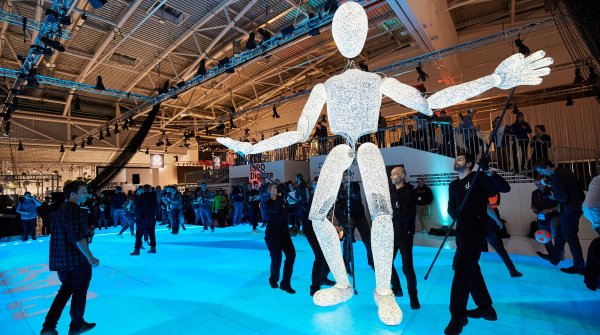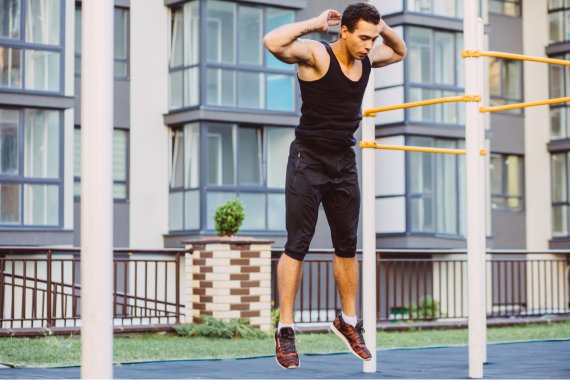
High Intensity Interval Training is, as the name suggests, extremely intensive. Especially for beginners this can be overly demanding. In order to avoid injuries or ineffective exercise execution, we have selected HIIT exercises that can be performed effectively and safely by beginners and advanced users alike.
HIIT can be performed with or without equipment. However, heavier weights and more complex exercises are more suitable for more advanced athletes. Therefore, we have limited our choice to exercises with your own body weight - they are safe and can be performed anywhere at any time.
No matter which exercise we use for our fitness training, the rule is: quality before quantity. To ensure that we train effectively and safely, we must perform the exercises cleanly. Therefore the first quality standard is clean exercise performance. The exercises must be performed correctly (not perfectly) even under fatigue. This is especially important in the beginning to avoid making mistakes.
In the same way, HIIT training only works if the appropriate intensity is given. Therefore, it is important to really use the stress phases of the training! It is better to work a little slower and keep up the load time than to burn out in the first seconds.Accordingly, our second quality standard is intensity. Only those who train intensively can enjoy all the benefits of HIIT.
In the same way, however, the breaks should also be used well: During the (often short) breaks, it is important to regenerate as much as possible. A lot is happening here around breathing: if you get your breath under control as quickly as possible, you are better supplied with oxygen. The break can also be used for a quick (small) sip of water. But as soon as the next training phase begins, you should be ready to start again.The third and final quality standard is therefore intelligent use of breaks.
With the right exercises and appropriate training standards, nothing stands in the way of HIIT! In the following we explain which exercises can be used for training effectively and how to perform them correctly
The squat is an effective exercise to move both the hips and the knees, as well as strengthening the legs. Depending on the individual anatomy, the exercise can be performed in a narrower or wider stance.
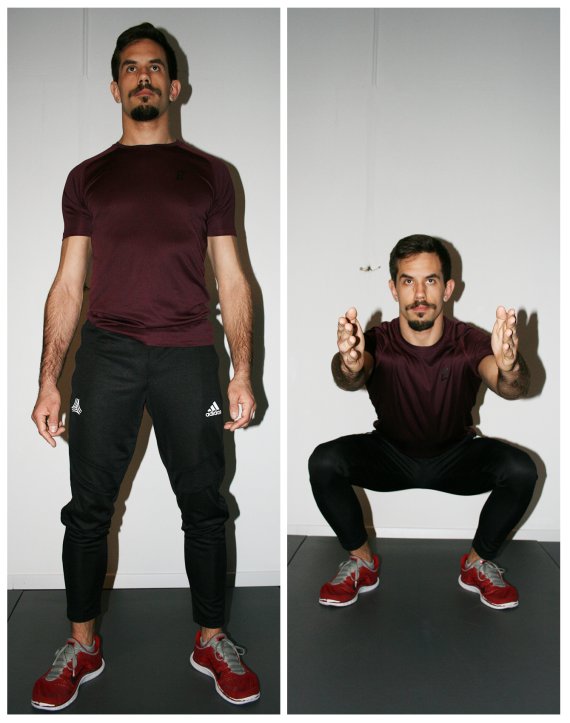
Starting position
We start from a hip to shoulder width stand, the shoulder blades are contractedand the stomach on tension. At the same time our toes grab the ground and the tips of your feet point slightly outwards.
Depth Position
To get into the low position we push our knees outwards and at the same timeour hips back. We keep our balance by leading our arms forward.We hold our chest high and look forward. From here we push ourselves up again by a powerful hip and leg extension.
The Plank is a classic core exercise, in which the hull is held statically against gravity.
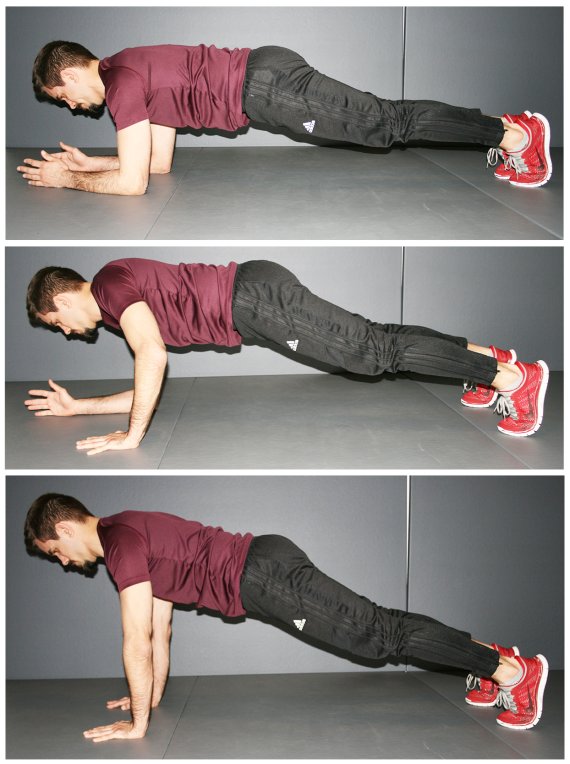
Start position/stop position
We support ourselves with our forearms on the floor, paying attention to keeping our upper body straight by tension in our stomach and knees. We either place the elbows directly under the shoulders or as a more difficult version a small distance in front of the shoulders. Our hands remain open. As an advanced variant, it is also possible to switch between high and low planking.
End position
We put one arm after the other with the hand on the floor and press ourselves as high up as possible to get into the the high plank. Afterwards we go back into the start position. When changing we pay attention to a stable upper body. Only when this is given, we should select a higher frequency of positional shifts.
The Bridge is a simple but effective exercise for hip extension.
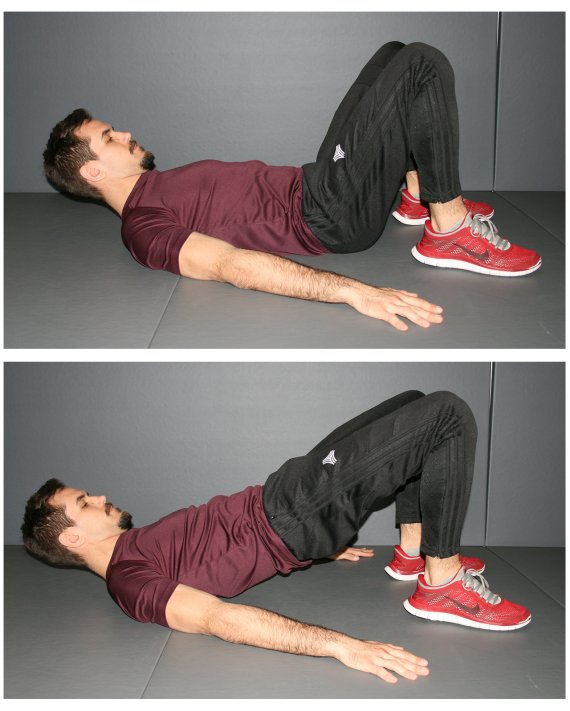
Starting position
At the beginning, lie on your back and place your feet outside your hips, near your buttocks. We put the arms on the floor to the side to stabilize. It's important to place you chin on your chest to get a straight spine.
End position
By tensing the buttocks we create a powerful hip extension, which we maintain at the upper point for about one second before we move on to the start position. But here we spend only little time and touch the floor for just a moment before we lift the hips again. When lifting the hips, keep the chin on the chest. Try not to overstretch the back.
As an alternative, the upper edge of the shoulder blades can also be placed on a raised surface.This exercise is called "Hip Thrust". This makes the movement more demanding for the thighs.
The Burpee is an endurance and strength exercise for the whole body. Because of the constant change of situation our heart has to do a lot of work, at the same time the jump and the push up train our arms and legs.
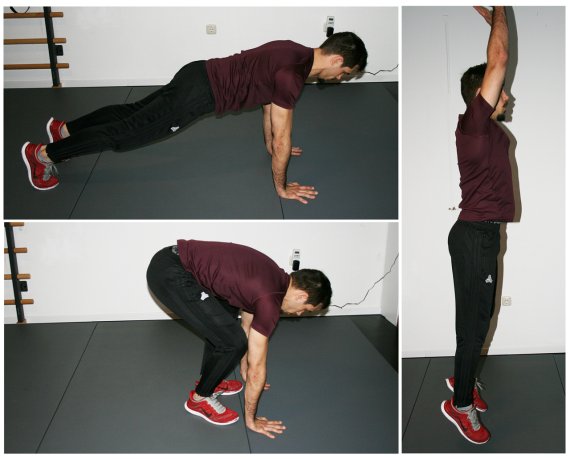
Starting position
We start the exercise in the push up position. The hands are under the shoulders and the body forms a straight line.
Interim position
Now we get our feet to our hands in one sentence and prepare for the jump.
Interim position
We explosively jump into and stretch our whole body. It is important to leave the ground with your feet. At the same time we try to touch the ceiling with our fingertips.
Interim position
After landing we put our hands back on the ground and jump back into the starting position. This variant of the Burpee deliberately avoids bending the arms towards the push-up: Due to the high intensity and associated fatigue, this presents an unnecessary risk of hyperextension of the lower back.
A strengthening exercise for the legs in which we alternately bend one leg while standing.
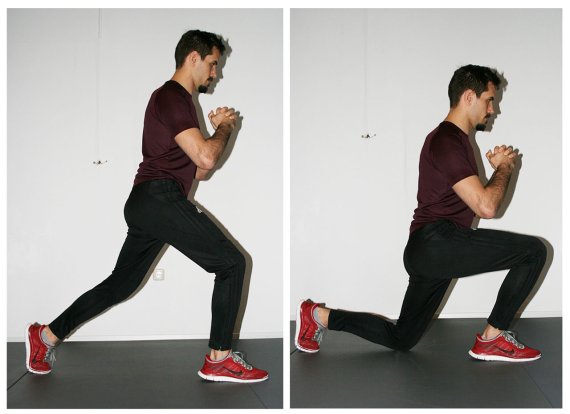
Starting position
For the starting position we move into a lunge.The correct length can be easily figured out. Just stand with your legs together and "fall forward". Use one leg to stop the fall. This automatically results in the optimal step length. At the same time we put our hands together in front of the chest and build up abdominal tension.The upper body follows the hips in the form of a slight forward tilt.A vertical position would possibly pull us into a hollow back.
Interim position
Now we bend our knee in a controlled manner and tap our back knee to the floor. We do not lower ourselves completely, so that the back knee does not carry any body weight. Additionally we have to keep up the muscle tension in our legs. Afterwards we push ourselves powerfully back up to the starting position. We should do this exercise after half of the exercise time with the other leg.
The only exercise for which we need some equipment. In the simplified version, the TRX can also be replaced by a door frame, for example.
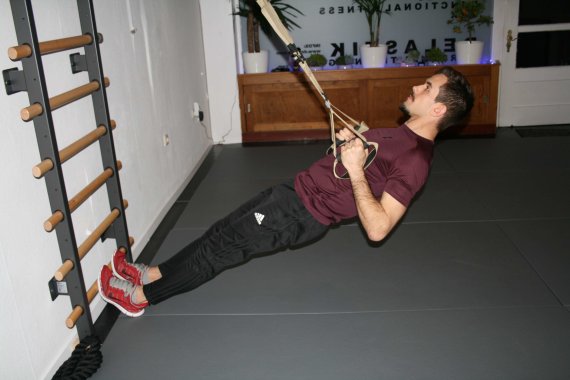
Starting position
In the starting position, we make sure that you are already standing (beginner) or Lying (advanced) to build up a body tension:For this we tense the abdomen and pull the shoulder blades together.Our arms hang stretched out in the TRX or on an edge/door frame.
Interim position
Next we pull ourselves forward or upwards by powerfully bending our arms. At the same time we bring our own hands towards our ribs and push the shoulder blades together. After a short pause (about one second) we slowly return to the starting position.
The pushup is one of the most popular exercises and ideal for HIIT. It can be carried out on any level surface.
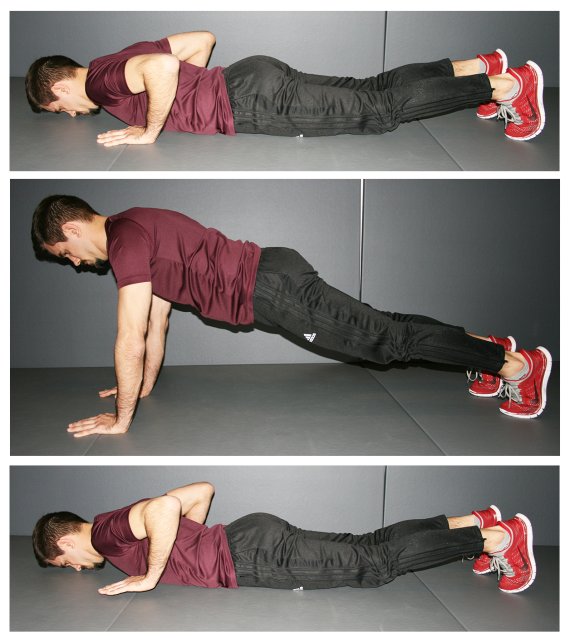
Starting position
We start with the hands under our shoulders and elbows stretched out. The stomach is tense and the knees are stretched. The body thus forms a line from the head to the feet. We must never lose this straight line during the pushup. Alternatively, beginners can place their hands on a raise to make the exercise easier. Only when this too is too heavy, we go down on our knees.
Interim position
We bring our upper body to the ground by bending our arms (the forehead is not enough). We keep the body tension especially in the abdomen. For self-control we can lift our hands briefly from the ground.
Start/end position
Now we bring ourselves back up from the intermediate position by powerfully stretching our arms. We have to make sure not to lose our abdominal tension. Otherwise we lose the straight line in the body.
High Intensity Interval Training is not part of our Top Trends 2020 for nothing: The versatile training method allows us to train both strength and endurance in a time-efficient way. With a program tailored to the individual training level, nothing stands in the way of improved fitness - not even the notorious lack of time.
 Know-HowThe 11 Best TRX Exercises
Know-HowThe 11 Best TRX Exercises
- ISPO awards
- Mountain sports
- Bike
- Design
- Retail
- Fitness
- Health
- ISPO Job Market
- ISPO Munich
- ISPO Shanghai
- Running
- Brands
- Sustainability
- Olympia
- OutDoor
- Promotion
- Sports Business
- ISPO Textrends
- Triathlon
- Water sports
- Winter sports
- eSports
- SportsTech
- OutDoor by ISPO
- Heroes
- Transformation
- Sport Fashion
- Urban Culture
- Challenges of a CEO
- Trade fairs
- Sports
- Find the Balance
- Product reviews
- Newsletter Exclusive Area
- Magazine



